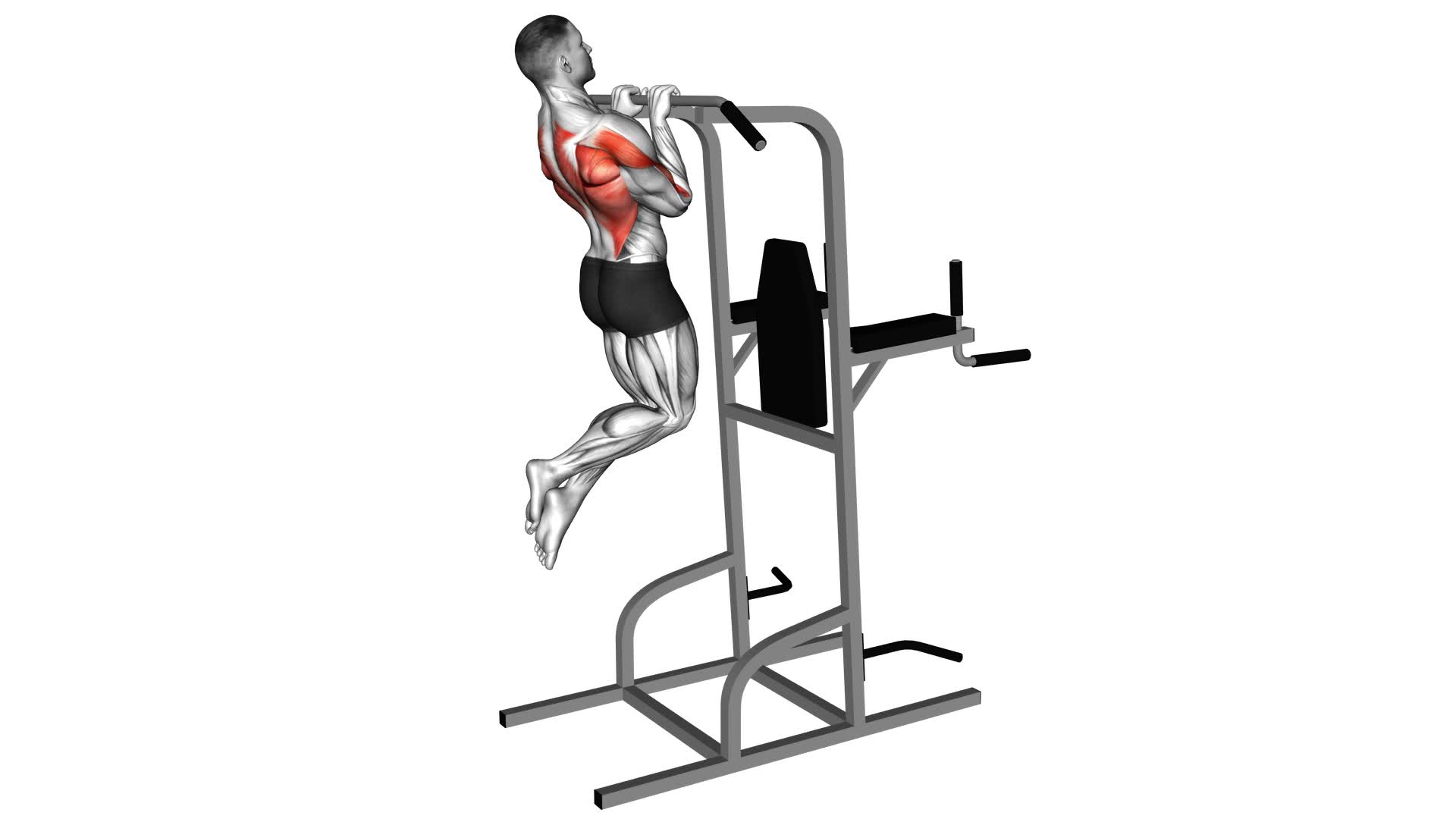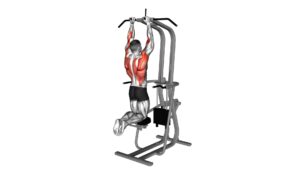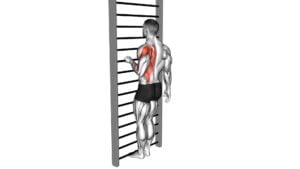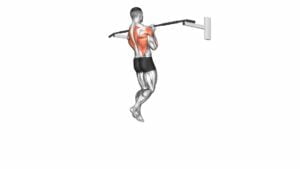Close Grip Pull-up – Video Exercise Guide & Tips

Looking to boost your upper body strength and target those hard-to-reach muscles? Look no further than the close grip pull-up! In this video exercise guide, we'll walk you through the proper form and technique.
Watch This Exercise Video
We'll also discuss the importance of hand placement and highlight the targeted muscle groups. Additionally, we'll provide helpful tips for avoiding common mistakes.
Plus, we'll show you progression and modification options to challenge yourself.
Get ready to increase your pull-up strength and achieve your fitness goals!
Key Takeaways
- Proper hand placement on the pull-up bar is crucial for proper form and technique.
- Close grip pull-ups engage the biceps, forearms, and upper back muscles.
- Avoid common mistakes such as allowing elbows to flare out and failing to properly retract scapulae.
- Progress and modify the exercise to increase difficulty, such as adding weight or using assistance bands.
Proper Form and Technique
To perform a close grip pull-up with proper form and technique, position your hands shoulder-width apart on the pull-up bar. This hand positioning is crucial for building upper body strength effectively. By keeping your hands close together, you engage the muscles in your arms, shoulders, and back more intensely, leading to greater strength gains.
When gripping the bar, wrap your fingers around it firmly and maintain a tight grip throughout the exercise. This will provide stability and prevent your hands from slipping during the movement. As you pull yourself up, focus on squeezing your shoulder blades together and pulling your elbows down towards your sides. This will activate your lats and biceps, maximizing the benefits of the exercise.
Maintaining a controlled and smooth motion is important to avoid injury and ensure proper muscle activation. Avoid swinging or using momentum to complete the movement. Instead, use your upper body strength to lift yourself up and lower yourself down in a controlled manner.
Now that you understand the proper form and technique for close grip pull-ups, let's move on to the next section, where we'll discuss the importance of hand placement in further detail.
Importance of Hand Placement
Maintain optimal hand placement on the pull-up bar to ensure proper engagement of the targeted muscles and maximize the effectiveness of the close grip pull-up. Hand positioning plays a crucial role in this exercise, as it determines the amount of stress placed on specific muscle groups and helps develop grip strength.
Here are some important points to consider:
- Width of hand placement: Place your hands slightly narrower than shoulder-width apart to target the muscles in the middle of your back, such as the rhomboids and lower trapezius.
- *Benefits*: This hand position increases the range of motion and puts more emphasis on the muscles in the middle of your back, leading to better muscle development and improved posture.
- Grip strength development: Use an overhand grip (palms facing away from you) to challenge your grip strength even further.
- *Benefits*: This grip variation not only targets the muscles in your back but also engages your forearm muscles and improves your overall grip strength.
Targeted Muscle Groups
Engage your biceps, forearms, and upper back muscles during the close grip pull-up exercise. The close grip pull-up is a compound exercise that targets multiple muscle groups simultaneously, making it an effective addition to your workout routine. By customizing your grip placement, you can increase or decrease the emphasis on different muscle groups.
The primary muscle groups targeted during the close grip pull-up are the biceps and forearms. As you pull your body up towards the bar, your biceps are responsible for the majority of the movement. Your forearms, particularly the brachialis and brachioradialis muscles, assist in the pulling motion, providing stability and strength.
Additionally, the close grip pull-up heavily engages your upper back muscles, specifically the latissimus dorsi (lats). The lats play a crucial role in pulling movements, and by performing close grip pull-ups, you can effectively strengthen and develop these muscles.
Other muscle groups that are engaged to a lesser extent during close grip pull-ups include the rhomboids, trapezius, and rear deltoids.
Incorporating close grip pull-ups into your workout routine offers several benefits. It helps build upper body strength and muscle mass, improves grip strength, enhances overall back development, and promotes better posture. Remember to vary your grip width and experiment with different hand placements to target different muscle groups and achieve a well-rounded upper body workout.
Common Mistakes to Avoid
When performing close grip pull-ups, it's important to avoid common mistakes that can hinder your progress.
One common mistake is allowing your elbows to flare out to the sides, which puts unnecessary strain on your shoulders and reduces the effectiveness of the exercise.
Another mistake is failing to properly retract your scapulae, which can limit the range of motion and decrease the engagement of the targeted muscles.
Additionally, having weak grip strength can make it difficult to perform the exercise correctly, so it's crucial to work on strengthening your grip to avoid this mistake.
Elbows Too Wide
To avoid the common mistake of having your elbows too wide during a close grip pull-up, ensure that you maintain proper form and positioning throughout the exercise. Here are some tips to help you maintain proper elbow alignment and shoulder stability:
- Keep your elbows close to your body throughout the movement. This helps engage the muscles in your upper back and arms more effectively. It also reduces strain on your shoulder joints and improves stability.
- Focus on pulling your shoulder blades down and back. This helps to activate the muscles in your upper back and improve scapular retraction. Proper scapular retraction ensures that your shoulders are in a stable position throughout the exercise.
By following these guidelines, you can avoid the mistake of having your elbows too wide and maintain proper form and shoulder stability during close grip pull-ups.
In the next section, we'll discuss the common mistake of lack of scapular retraction.
Lack of Scapular Retraction
To maintain proper form and shoulder stability during close grip pull-ups, it's important to address the common mistake of lack of scapular retraction.
Scapular retraction refers to the movement of pulling your shoulder blades together towards the spine. This movement helps to stabilize the shoulders and engage the muscles of the upper back, which is crucial for maintaining proper form during close grip pull-ups.
When you fail to retract your scapulae, you put unnecessary stress on your shoulders and decrease the effectiveness of the exercise. To avoid this mistake, focus on squeezing your shoulder blades together as you pull yourself up. This won't only improve your shoulder stability, but also enhance the activation of the muscles in your upper back.
Now let's move on to the next common mistake: weak grip strength.
Weak Grip Strength
If you have weak grip strength, it can hinder your ability to properly perform close grip pull-ups and maintain proper form and shoulder stability. To improve your grip strength and avoid common mistakes, consider the following tips:
- Use grip strength exercises: Incorporate exercises specifically designed to target and improve grip strength into your workout routine. This can include exercises such as farmer's walks, deadlifts, and wrist curls.
- Farmer's walks: Hold heavy dumbbells or kettlebells and walk a designated distance. This exercise challenges your grip strength and overall body stability.
- Deadlifts: This compound exercise not only works your lower body and back muscles but also engages your grip strength as you hold onto the barbell.
Progression and Modifications
Now let's talk about how you can progress and modify your close grip pull-ups to challenge yourself even more.
Increasing the difficulty level can be done by adding weight to your body, whether it's through a weight belt or holding a dumbbell between your feet.
It's also important to incorporate injury prevention techniques, such as proper warm-up and stretching, to ensure you're performing the exercise safely.
Lastly, don't forget to customize the exercise to your individual needs, whether that means adjusting the grip width or using assistance bands to gradually build strength.
Increasing Difficulty Level
Challenge yourself by gradually increasing the difficulty level of the close grip pull-up exercise through progressive modifications. Here are some ways to intensify your training and add variety to your workouts:
- Adding Weight: Attach a weight plate or wear a weighted vest to increase the resistance and make the exercise more challenging.
- Negatives: Start at the top position of the pull-up and slowly lower yourself down, focusing on the eccentric phase. This increases the intensity and builds strength.
- Assisted Variations: Use resistance bands or an assisted pull-up machine to provide assistance and gradually reduce the assistance as you get stronger.
- Wide Grip Pull-ups: Perform pull-ups with a wider grip to target different muscles and increase the difficulty level.
Injury Prevention Techniques
To prevent injuries while performing close grip pull-ups, it's important to incorporate proper progression and modifications into your training routine.
One way to prevent injury is by gradually increasing the difficulty level of your exercises. This can be done by using resistance bands or adding weight to your pull-ups as you become stronger.
Additionally, incorporating strengthening exercises for the muscles involved in close grip pull-ups, such as the biceps and back muscles, can help prevent strain and injury.
Before starting your pull-up routine, it's crucial to warm up properly to increase blood flow to the muscles and prepare them for the workout. This can be done through dynamic stretches and light cardio exercises.
Customizing for Individual Needs
To customize your close grip pull-up routine for your individual needs, consider incorporating progression and modifications that suit your fitness level and goals. Here are some customizing modifications and injury prevention techniques to help you get the most out of your close grip pull-up workout:
Progression options:
- Use resistance bands: Attach a resistance band to the bar and place your foot or knee in it to reduce the weight you have to pull.
- Assisted pull-up machine: Utilize the assisted pull-up machine to gradually decrease the assistance as you get stronger.
Modifications for different fitness levels:
- Beginner: Start with inverted rows or use a chair to assist you in performing the movement.
- Advanced: Add weight by using a weight belt or holding a dumbbell between your legs.
Remember to always warm up properly and listen to your body to prevent injuries. Start slow and gradually increase the difficulty of your close grip pull-up routine as you progress.
Tips for Increasing Pull-up Strength
To increase your pull-up strength, focus on incorporating compound exercises that target your back and arm muscles. Compound exercises involve multiple muscle groups, making them effective for building overall strength. One way to do this is by using a variety of grip positions. Different grip positions target different muscles in your back and arms, allowing you to work them from various angles and intensities.
For example, wide grip pull-ups primarily target your lats, while close grip pull-ups emphasize your biceps and upper back.
In addition to using different grip positions, incorporating assistance exercises can also help increase your pull-up strength. These exercises target the specific muscles involved in pull-ups, allowing you to build strength and improve your performance. Some effective assistance exercises include lat pulldowns, inverted rows, and bicep curls.
Lat pulldowns mimic the movement of pull-ups and can help you build the necessary strength. Inverted rows work your upper back muscles, which are crucial for pull-ups. Bicep curls specifically target your biceps, which play a significant role in pulling movements.
Frequently Asked Questions
How Many Sets and Reps Should I Do When Performing Close Grip Pull-Ups?
When performing close grip pull-ups, it's important to focus on sets and reps that challenge your muscles without causing excessive strain. Start with 3 sets of 8 reps and gradually increase the intensity as you progress.
Avoid common mistakes like using momentum or improper form, as this can lead to injury.
To progress in close grip pull-ups, gradually increase the number of reps or sets, or try adding weight to make the exercise more challenging.
Can Close Grip Pull-Ups Be Done on a Regular Pull-Up Bar or Is a Specific Grip Bar Required?
Yes, you can perform close grip pull-ups on a regular pull-up bar. The specific grip bar isn't required.
Close grip pull-ups are a variation of the traditional pull-up exercise where your hands are placed closer together on the bar. This grip targets your biceps, forearms, and upper back muscles.
It's an effective exercise for building upper body strength and can be incorporated into your workout routine to add variety and challenge.
Are Close Grip Pull-Ups Suitable for Beginners or Should They Be Done by More Advanced Individuals?
Close grip pull-ups can be suitable for both beginners and advanced individuals.
For beginners, modifications like using an assisted pull-up machine or resistance bands can help build strength and gradually progress to unassisted pull-ups.
Close grip pull-ups offer several benefits for advanced individuals, such as targeting the muscles in the back, arms, and shoulders more intensely. They also engage the core muscles and improve grip strength.
Regular practice and proper form are key to mastering close grip pull-ups.
Can Close Grip Pull-Ups Help With Improving Grip Strength?
Close grip pull-ups are a great exercise for improving grip strength. By using a narrow grip, you engage your forearm muscles more, which helps to strengthen your grip.
Regular pull-ups also work the muscles in your upper body, but the close grip variation specifically targets the forearms.
This exercise is beneficial for upper body strength training overall, as it targets multiple muscle groups including the back, shoulders, and arms.
Incorporating close grip pull-ups into your routine can help you develop a stronger grip and improve your overall upper body strength.
Are There Any Alternative Exercises That Can Be Done to Target the Same Muscle Groups as Close Grip Pull-Ups?
If you're looking for alternative exercises to target the same muscle groups as close grip pull-ups, you can try TRX rows and dumbbell bent over rows.
TRX rows are great for engaging your back muscles, while dumbbell bent over rows specifically target your lats and upper back.
Both exercises are effective for building strength and improving grip.
Adding these exercises to your routine can help you achieve your fitness goals and diversify your workouts.
Conclusion
In conclusion, performing close grip pull-ups with proper form and hand placement can effectively target various muscle groups.
By avoiding common mistakes and gradually progressing, you can increase your pull-up strength over time.
Remember to prioritize technique and listen to your body to avoid injuries.
With consistency and dedication, you can achieve impressive results with this challenging exercise.

Author
Years ago, the spark of my life’s passion ignited in my mind the moment I stepped into the local gym for the first time. The inaugural bead of perspiration, the initial endeavor, the very first surge of endorphins, and a sense of pride that washed over me post-workout marked the beginning of my deep-seated interest in strength sports, fitness, and sports nutrition. This very curiosity blossomed rapidly into a profound fascination, propelling me to earn a Master’s degree in Physical Education from the Academy of Physical Education in Krakow, followed by a Sports Manager diploma from the Jagiellonian University. My journey of growth led me to gain more specialized qualifications, such as being a certified personal trainer with a focus on sports dietetics, a lifeguard, and an instructor for wellness and corrective gymnastics. Theoretical knowledge paired seamlessly with practical experience, reinforcing my belief that the transformation of individuals under my guidance was also a reflection of my personal growth. This belief holds true even today. Each day, I strive to push the boundaries and explore new realms. These realms gently elevate me to greater heights. The unique combination of passion for my field and the continuous quest for growth fuels my drive to break new ground.







